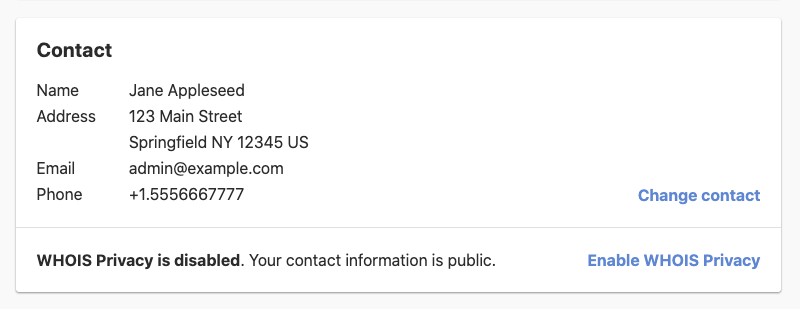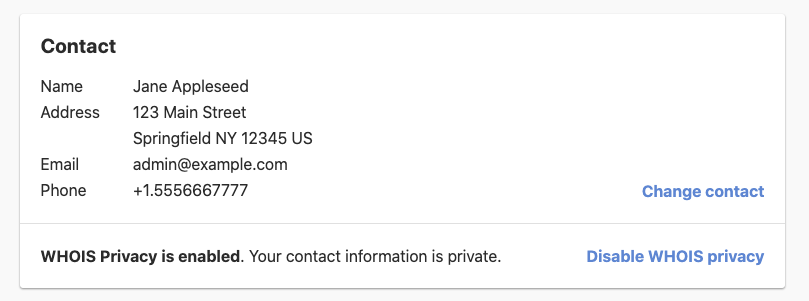Domain WHOIS Privacy protection
Table of Contents
The WHOIS Privacy protection service keeps your contact information private for a domain. This service replaces the public information you provide with an anonymous proxy identity in the public WHOIS database.
You can enable WHOIS Privacy protection for any of your domains any time, as long as the domain is registered with us and the TLD (Top Level Domain) supports the WHOIS Privacy service. You can check if a TLD supports WHOIS Privacy from the list of supported TLDs.
The WHOIS Privacy service is now free for domains registered with us.
Enabling WHOIS Privacy
You can enable WHOIS Privacy protection from your domain page.
Enabling WHOIS Privacy from the domain page
- Log in to DNSimple with your user credentials.
- If you have more than one account, select the relevant one.
- On the header, click the tab, locate the relevant domain, and click the name to access the domain page.
-
Scroll down to the Contact card. It will indicate if the WHOIS Privacy service is enabled.

- To enable the WHOIS Privacy service, click the link.
Disabling WHOIS Privacy
You can disable WHOIS Privacy protection from your domain page.
You can reactivate your domain’s WHOIS Privacy protection any time until the protection service expires without paying for it again.
Once you disable WHOIS Privacy protection, the contact details of your domain will be public.
Disable WHOIS Privacy from the domain page
- Log in to DNSimple with your user credentials.
- If you have more than one account, select the relevant one.
- On the header, click the tab, locate the relevant domain, and click the name to access the domain page.
-
Scroll down to the Contact card. It will indicate if the WHOIS Privacy service is enabled.

- To disable the WHOIS Privacy service, click the link.
WHOIS Privacy and GDPR
For generic TLDs (gTLDs) like .com, .net, and .org, WHOIS privacy isn’t necessary, because the information will be redacted through GDPR. This also applies to new TLDs (nTLDs) like .app, .dev, and others.
For country code TLDs (ccTLDs), check the policies for the specific TLD to determine their stance on WHOIS data, and apply WHOIS privacy when it’s available.